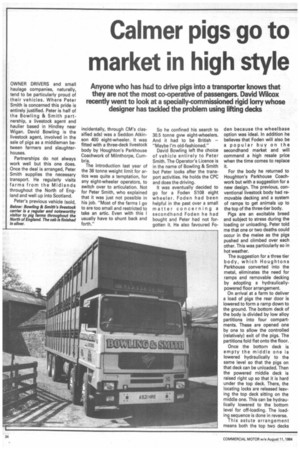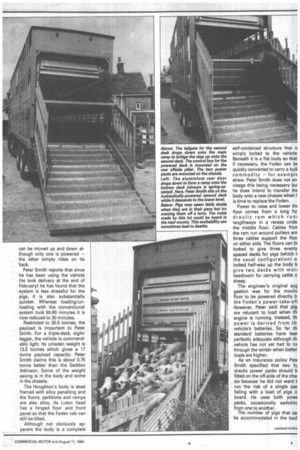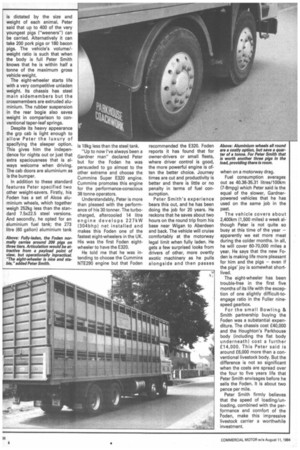Calmer pigs go to market in high style
Page 36

Page 37

Page 38

If you've noticed an error in this article please click here to report it so we can fix it.
Anyone who has had to drive pigs into a transporter knows that they are not the most co-operative of passengers. David Wilcox recently went to look at a specially-commissioned rigid lorry whose designer has tackled the problem using lifting decks
OWNER DRIVERS and small haulage companies, naturally, tend to be particularly proud of their vehicles. Where Peter Smith is concerned this pride is entirely. justified. Peter is half of the Bowling & Smith partnership, a livestock agent and haulier based in Hindley near Wigan. David Bowling is the livestock agent, involved in the sale of pigs as a middleman between farmers and slaughterhouses.
Partnerships do not always work well but this one does. Once the deal is arranged, Peter Smith supplies the necessary transport. He regularly visits farms from the Midlands throughout the North of England and well up into Scotland.
Peter's previous vehicle (sold,
Below: Bowling & Smith's livestock carrier is a regular and noteworthy visitor to pig farms throughout the North of England. The cal, is finished in silver.
incidentally, through CM's classified ads) was a Seddon Atkinson 400 eight-wheeler. It was fitted with a three-deck livestock body by Houghton's Parkhouse Coachwork of Milnthorpe, Cumbria.
The introduction last year of the 38 tonne weight limit for artics was quite a temptation, for any eight-wheeler operators, to switch over to articulation. Not for Peter Smith, who explained that it was just not possible in his job. "Most of the farms I go to are too small and restricted to take an artic. Even with this I usually have to shunt back and forth." So he confined his search to 30.5 tonne gvw eight-wheelers. And it had to be British — "Maybe I'm old-fashioned." David Bowling left the choice of vehicle entirely to Peter Smith. The Operator's Licence is in the name of Bowling & Smith but Peter looks after the transport activities. He holds the CPC and does the driving.
It was eventually decided to go for a Foden S108 eight wheeler. Foden had been helpful in the past over a small matter concerning a secondhand Foden he had bought and Peter had not forgotten it. He also favoured Fo
den because the wheelbase option was ideal. In addition he believes that Foden will also be a popular buy on the secondhand market and will command a high resale price when the time comes to replace it.
For the body he returned to Houghton's Parkhouse Coachwork but with a suggestion for a new design. The previous, conventional livestock body had removable decking and a system of ramps to get animals up to the top of the three-tier body.
Pigs are an excitable breed and subject to stress during the loading or unloading. Peter told me that one or two deaths could occur in the melee as the pigs pushed and climbed over each other. This was particularly so in hot weather.
The suggestion for a three tier body, which Houghtons Parkhouse converted into the metal, eliminates the need for ramps and removable decking by adopting a hydraulicallypowered floor arrangement.
On arrival at a farm to deliver a load of pigs the rear door is lowered to form a ramp down to the ground. The bottom deck of the body is divided by low alloy partitions into four compartments. These are opened one by one to allow the controlled (relatively) exit of the pigs. The partitions fold flat onto the floor.
Once the bottom deck is empty the middle one is lowered hydraulically to the same level so that the pigs on that deck can be unloaded. Then the powered middle deck is raised right up so that it is hard under the top deck. There, the locating locks are released leaving the top deck sitting on the middle one. This can be hydraulically lowered to the bottom level for off-loading. The loading sequence is done in reverse.
This astute arrangement means both the top two decks can be moved up and down although only one is powered — the other simply rides on its back.
Peter Smith reports that since he has been using the vehicle (he took delivery at the end of February) he has found that the system is less stressful for the pigs. It is also substantially quicker. Whereas loading/unloading with the conventional system took 60-90 minutes it is now reduced to 30 minutes.
Restricted to 30.5 tonnes, the payload is important to Peter Smith. For a triple-deck, eightlegger, the vehicle is commendably light. Its unladen weight is 13.5 tonnes which gives a 17 tonne payload capacity. Peter Smith claims this is about 0.75 tonne better than the Seddon Atkinson. Some of the weight saving is in the body and some in the chassis.
The Houghton's body is steel framed with alloy panelling and the floors, partitions and ramps are also alloy. Its Luton head has a hinged floor and front panel so that the Foden cab can still be tilted.
Although not obviously apparent the body is a complete self-contained structure that i! simply bolted to the vehicle Beneath it is a flat body so that if necessary, the Foden can bE quickly converted to carry a bull commodity — for examplE straw. Peter Smith does not en visage this being necessary bu' he does intend to transfer thE body onto a new chassis when i is time to replace the Foden.
Power to raise and lower th( floor comes from a long hy draulic ram which run: lengthways in a recess undo the middle floor. Cables fron the ram run around pulleys an three cables support the floo on either side. The floors can IN locked to give three evenly spaced decks for pigs (which the usual configuration) o locked half-way up the body tc give two decks with mori headroom for carrying cattle o sheep.
The engineer's original sug gestion was for the movini floor to be powered directly b the Foden's power-take-ofl However, Peter said that pig are relucant to load when th engine is running. Instead, th power is derived from th vehicle's batteries. So far th standard batteries have bee perfectly adequate although th vehicle has not yet had to ru through the winter when batter loads are higher.
As an insurance policy PetE Smith specified that two h) draulic power packs should b fitted on the off-side of the cha: sis because he did not want t run the risk of a single pac failing with a load of pigs o board. He uses both powE packs, occasionally switchin from one to another.
The number of pigs that cal be accommodated in the bod. is dictated by the size and weight of each animal. Peter said that up to 400 of the very youngest pigs ("weeners") can be carried. Alternatively it can take 200 pork pigs or 180 bacon pigs. The vehicle's volume/weight ratio is such that when the body is full Peter Smith knows that he is within half a tonne of the maximum gross vehicle weight.
The eight-wheeler starts life with a very competitive unladen weight. Its chassis has steel main sidemembers but the crossmembers are extruded aluminium. The rubber suspension in the rear bogie also saves weight in comparison to conventional taper-leaf springs.
Despite its heavy appearance the grp cab is light enough to allow Peter the luxury of specifying the sleeper option. This gives him the independence for nights out or just that extra spaciousness that is always welcome when driving. The cab doors are aluminium as is the bumper.
In addition to these standard features Peter specified two other weight-savers. Firstly, his Foden has a set of Alcoa aluminium wheels, which together weigh 252kg less than the standard 7.5x22.5 steel versions. And secondly, he opted for an aluminium fuel tank; the 273 litre (60 gallon) aluminium tank is 18kg less than the steel tank.
"Up to now I've always been a Gardner man" declared Peter but for the Foden he was persuaded to go almost to the other extreme and choose the Cummins Super E320 engine. Cummins promotes this engine for the performance-conscious 38 tonne operators.
Understandably, Peter is more than pleased with the performance of his 30 tanner. The turbocharged, aftercooled 14 litre engine develops 227kW (304bhp) net installed and makes this Foden one of the fastest eight-wheelers in the UK. His was the first Foden eightwheeler to have the E320.
He told me that he was intending to choose the Cummins NTE290 engine but that Foden recommended the E320. Foden reports it has found that for owner-drivers or small fleets, where driver control is good, the more powerful engine is often the better choice. Journey times are cut and productivity is better and there is little or no penalty in terms of fuel consumption.
Peter Smith's experience bears this out, and he has been doing the job for 20 years. He reckons that he saves about two hours on the round trip from his base near Wigan to Aberdeen and back. The vehicle will cruise comfortably at the motorway legal limit when fully laden. He gets a few surprised looks from drivers of other, more overtly exotic machinery as he pulls alongside and then passes when on a motorway drag.
Fuel consumption averages out as 40.36-35.31 litres/100km (7-8mpg) which Peter said is the equal of the slower, Gardnerpowered vehicles that he has used on the same job in the past.
The vehicle covers about 2,400km (1,500 miles) a week although Peter is not quite so busy at this time of the year — apparently we eat more meat during the colder months. In all, he will cover 60-70,000 miles a year. He says that the new Foden is making life more pleasant for him and the pigs — even if the pigs' joy is somewhat shortlived.
The eight-wheeler has been trouble-free in the first five months of its life with the exception of one slightly difficult-toengage ratio in the Fuller ninespeed gearbox.
For the small Bowling & Smith partnership buying the Foden was a substantial expenditure. The chassis cost £40,000 and the Houghton's Parkhouse body (including the flat body underneath) cost a further £14,000. This Peter said is around £6,000 more than a conventional livestock body. But the difference is not so significant when the costs are spread over the four to five years life that Peter Smith envisages before he sells the Foden. It is about two pence per mile.
Peter Smith firmly believes that the speed of loading/unloading, combined with the performance and comfort of the Foden, make this impressive livestock carrier a worthwhile investment.




















































































